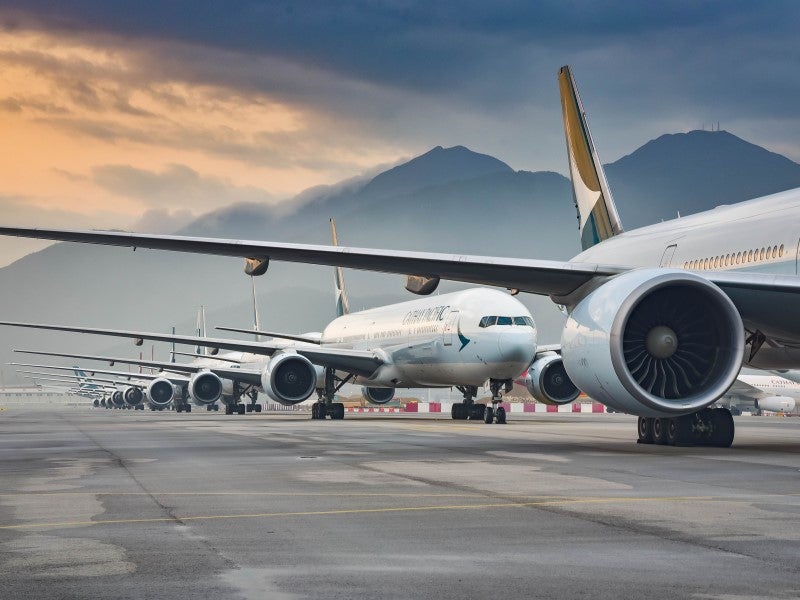
Since their introduction in the mid-1980s, asset-backed securities (ABS) have evolved continuously. In the aviation industry today, signs suggest ABS is adapting to Covid-19’s ‘new normal’. Alex O’Brien reports
Editor’s introduction: A way forward for asset-backed funding during the Covid pandemic?
The economic pressures of Covid-19 have brought about the latest developmental stage in the adaptation of bonds (or notes) backed by securitised assets, and how this has played out in the aviation leasing space speaks to the flexibility of ABS in times of economic crisis.
In recent years, the number of lessors accessing the aircraft ABS market and the issuance of aircraft ABS have skyrocketed.
In a pre-Covid-19 assessment of the industry, David McGovern, partner and head of asset finance (Ireland) with law firm Walkers, said: “The number of aviation ABS issuances in 2019 grew to 19 compared to 14 in 2018 while the value of ABS notes issued in 2019 reached $7.9bn, reflecting a 4% increase on the value of ABS notes issued in 2018.”
But, with the economic pressures of Covid-19 now at large in the market, there are signs the ABS aviation market has become overcrowded for newer aircraft. In this regard, for the first time in the industry’s history, supply is beginning to overtake demand.
While, traditionally, there has been a general consensus among investors for newer, liquid aircraft, particularly for young to mid-life narrow-body aircraft. From a risk/value perspective, older aircraft offer a far less risky investment proposition.
How well do you really know your competitors?
Access the most comprehensive Company Profiles on the market, powered by GlobalData. Save hours of research. Gain competitive edge.

Thank you!
Your download email will arrive shortly
Not ready to buy yet? Download a free sample
We are confident about the unique quality of our Company Profiles. However, we want you to make the most beneficial decision for your business, so we offer a free sample that you can download by submitting the below form
By GlobalDataQuite simply, older assets allow for a larger relative margin of error without endangering ultimate returns. This prompts the question: Do mid- to late-life aircraft offer a more attractive and secure portfolio than a younger fleet during times of market stress?
Clearly, there is an abundance of underlying motivations when investing in new aircraft. The release of new aircraft by Airbus and Boeing draws world attention, and rightly so. It goes without saying that many top lessors have in the past reaped the rewards of initiating a young fleet, boosting sales and lease revenues.
The argument has often been made that large risks come with holding on to vintage aircraft, especially if lessors have limited knowledge of the aircraft, or the ‘metal’ they are dealing in.
As a result of this demand for younger aircraft, congestion has created barriers to entry in the ABS space.
But, in recent years, an abundance of smaller, niche lessors have entered the market to take advantage of lessors whose portfolios of new aircraft have come under pressure from falling prices, and by investing in mid- to end-of-life aircraft, these new players have shown there clearly is money to be made.
As unlevered equity returns for leased aircraft have declined over the last five years, returns on older aircraft have proven significantly higher.
Expected returns for narrow-body aeroplanes are 3% to 5% on young, 6% to 10% on mid-life and 10%+ for older aircraft, according to research by Ishka, a provider of data, analytics and advisory services for the global aviation industry.
Although economic circumstances may fluctuate, these return figures are broadly expected to remain constant.
Following a consultation with Ishka, Patrick den Elzen, managing director of the Netherlands-based Arena Aviation Capital, said 4% or 5% return was not enough to compensate aircraft investors for the nature of their risk. “You should be looking on a portfolio basis at 8% to 10% after leverage,” he said.
High oil prices
Newer aircraft certainly attract investors due to better fuel-efficiency, but this efficiency comes with a price, which is higher ownership cost, according to a 2016 report by Alafco Aviation Lease and Finance, a Kuwait-based aviation lessor. But, during times of rock-bottom fuel prices, any efficiency gains are offset by high ownership costs.
Between 2010 and 2014, when fuel prices were particularly high, the retirement of end-of-life aircraft (such as A340and B747-400) was brought forward as a result.
Given the current low prices, the commercial life of these ‘vintage’ aircraft have been extended. So, as the price of crude oil drops, the acquisition of used aeroplanes increases, with a decline of investment in younger fleet.
This helps explain why an ABS transaction for older aircraft can be easily accessible, as well as extremely profitable, for investors.
When pitching an ABS portfolio to investors, aside from profit, lessees or aircraft, a major area of concern is security. What happens in the event of a recession? ABS transactions for mid-life aircraft help address investor concerns for collateral, security and protection.
In the event of an economic downturn, as Covid-19 has demonstrated, the aviation industry is typically significantly affected.
The value of aircraft is extremely volatile and has the potential to plummet in times of crisis.
Therefore, it is worth considering the difference in market (and part-out) value as a percentage between new and older aircraft. The part-out process involves an aircraft being withdrawn from service and dismantled.
For example, if you take a brand new aircraft, worth $65m, and a 12-year old aircraft worth $25m, in the event of a market crash, the value of both aircraft can only fall to a certain price point, however, younger aircraft fall from a higher starting point than the older aircraft. In terms of investments, total losses can weigh significantly on a portfolio.
While longer-term leases offer stability and a guaranteed ongoing tenancy, lengthy complex negotiations can create challenges for both parties, resulting in a greater likelihood of disputes. Additionally, as required, longer-term leases can be more difficult to terminate (or exit), given the higher probability for unexpected outlays in maintenance, fees, etc.
Short-term leases associated with mid-life aircraft come with their own issues. The flexibility of short-term leases can be very attractive to investors, but the onus is on investors to be constantly on the lookout for the next investment.
Mid-life crisis?
An extensive list of risk factors is likely associated with mid- to end-of-life aircraft investment. The wear and tear associated with ageing aircraft, and ongoing maintenance, can drive up costs significantly, especially if a detailed history of the aircraft is not clearly known prior to transaction.
Also, mid- to end-of-life aircraft tend to attract a higher level of volatility in value, so understanding the ‘metal’ behind each transaction is seen by industry players as key to a successful deal.
Damon D’Agostino, chief executive of Ireland-based aviation lessor Zephyrus Aviation Capital, is one such individual who has taken full advantage of the congestion in the market for new aircraft.
Although jumping straight into the ABS market may have looked imprudent from the outside, D’Agostino says: “Older assets can be riskier if you don’t understand the metal, but given our experience and expertise we can mitigate the risk by proactively managing the metal through the end of its lifecycle.”
By focusing on wide-body and narrow-body planes, the Zephyrus business plan is built around acquiring these aircraft in the last two-quarters of their economic life, through a part-out and trading-based exit strategy.
In May 2019, Zephyrus was awarded the ‘North American Deal of the Year 2018’ by the Air Finance Journal (an aviation business news publisher and part of the Euromoney Institutional Investor PLC group).
The award recognised ZCAP 2018-1, an ABS transaction valued at $336.6m in secured notes to finance the acquisition of a large portfolio of aircraft. The financing represented the company’s first structured ABS financing.
This transaction consisted of 21 mid- to late-life Airbus and Boeing aircraft.
The 21 aircraft have a weighted average age of approximately 13.3 years and a remaining average lease term of approximately 2.9 years.
This ABS transaction represents a wide variety of lessees strengthening a diverse portfolio. The majority of the aircraft, although entering mid-life, are primarily liquid narrow-body models.
Significantly, this transaction shows how the ABS market is being used effectively to fund new aircraft lessors.
The half-life of this transaction is quite low in comparison to other ABS transactions with aircraft of similar age and remaining lease terms.
In older aircraft, it is more appropriate to use half-life value to project future lease rentals because it is more stable than using the maintenance-adjusted value, which is seen as volatile because it relies on an aircraft’s actual maintenance status, according to Deborah Newman, director at Standard & Poor’s.
With a weighted average age of 13.3 years, the portfolio is viewed as a mid-to end-of-life aircraft deal. Although these aircraft models are still in production, aircraft that are manufactured near the end of the model’s production tend to have higher volatility in value retention than earlier produced aircraft.
Covid-19 & ABS
The aviation industry has clearly been a casualty of Covid-19, from which the aircraft leasing sector has not been exempted. Despite this, ABS transactions have proven to be attractive for investors, particularly because of the greater risk spread (and lack of concentration risk) they afford due to the geographical diversity, though country placement, of every ABS.
As a result of the coronavirus, the market value of aircraft has been negatively affected, both for newer and for mid- to end of life aircraft. However, as we have seen, it is the younger fleet whose value will plummet furthest.
Younger asset classes across all industries, besides property, are subject to a faster initial depreciating profile, levelling out eventually. However, during times of market distress, such as Covid-19, these values depreciate at even a higher rate.
During periods of distress, aircraft values of newer fleet have historically suffered a more devastating drop in value compared to older fleets, just as ABS transactions in mid-life aircraft offer better returns at the same time.
Liquidity is expected to play a major role in ABS structures in the current climate where cash is scarce for lessors and airlines alike, and without underlying cash funds, ABS transactions will inevitably default, creating huge risk for many portfolios.
Airline bankruptcy will certainly be tested but as mentioned earlier, one or two defaults can be offset thanks to greater portfolio diversification.
Whilst younger aircraft will experience a greater loss in value, many older aircraft may be sold out in parts and some may undergo cargo conversions.
Although at first glance this form of aircraft retirement may not seem appealing, in the current climate where cash is king, this part-out strategy may provide essential working capital that could help manage the difficulties brought about by Covid-19.
Mike Yeomans, head of valuations for IBA Group, an independent aviation consultancy based in the UK, in a recent webinar outlined how lease rates are expected to fall in the event of Covid-19 inspired market default.
However, it is worth noting the difference in marginal lease declines. Similar to the effects on market value, three-year-old aircraft are expected to suffer more dramatic reductions in lease rates compared to 12-year old aircraft, across both wide-body and narrow-body planes.
So far we have seen how against the economic backdrop of Covid-19, the ABS industry’s bias for new fleet and new technology has been exposed. The danger of purchasing young aircraft is that it carries the risk of a much higher marginal default.
By weighing the evidence on market values and lease rates, it is fair to conclude that young aircraft will be negatively impacted in a downturn, and given the dominance of supply over demand in the medium term, this will certainly take its toll on the aircraft leasing sector.
End-of-life fleets
In such a congested market, ABS transactions in mid- to end-of-life fleets, as we have seen, will certainly prove the least risky.
There is evidence to corroborate that low lease rates and fuel prices drive up the demand for mid- to end-of-life aircraft. Historic data suggests that mid-life ABS transactions offer a greater unlevered equity returns than a younger fleet, for both narrow-body and wide-body aircraft.
Also, during an economic crisis, the marginal drop in value of newer aircraft far exceeds that of mid- to end-of-life assets.
Given the unpredictability of the aircraft leasing industry and the current unprecedented unfolding economic crisis that is Covid-19, entrepreneurial know-how will certainly be tested.
With key economic indicators pointing south, triggering deferrals and early redelivery requests, the lessor market is nevertheless expected to eventually recover.
And when it does, a ‘new normal’ may emerge for the ABS aviation industry, but more importantly new opportunities will also arise. The top 10 leasing companies may be expected to continue to invest exclusively in younger aircraft, offloading their vintage assets as they see fit.
Nonetheless, a new market phenomenon, of mid- to end-of-life ABS, may have done enough to prove its net worth in this exceedingly overcrowded market.
Alex O’Brien graduated from Embry-Riddle Aeronautical University in Florida, US, with a BSc in Finance. He is beginning an MSc in Aviation Finance at University College Dublin’s Michael Smurfit Business School.







